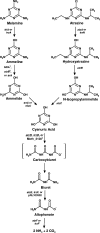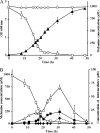Plasmid localization and organization of melamine degradation genes in Rhodococcus sp. strain Mel
- PMID: 22210223
- PMCID: PMC3294463
- DOI: 10.1128/AEM.06468-11
Plasmid localization and organization of melamine degradation genes in Rhodococcus sp. strain Mel
Abstract
Rhodococcus sp. strain Mel was isolated from soil by enrichment and grew in minimal medium with melamine as the sole N source with a doubling time of 3.5 h. Stoichiometry studies showed that all six nitrogen atoms of melamine were assimilated. The genome was sequenced by Roche 454 pyrosequencing to 13× coverage, and a 22.3-kb DNA region was found to contain a homolog to the melamine deaminase gene trzA. Mutagenesis studies showed that the cyanuric acid hydrolase and biuret hydrolase genes were clustered together on a different 17.9-kb contig. Curing and gene transfer studies indicated that 4 of 6 genes required for the complete degradation of melamine were located on an ∼265-kb self-transmissible linear plasmid (pMel2), but this plasmid was not required for ammeline deamination. The Rhodococcus sp. strain Mel melamine metabolic pathway genes were located in at least three noncontiguous regions of the genome, and the plasmid-borne genes encoding enzymes for melamine metabolism were likely recently acquired.
Figures





References
-
- Assaf NA, Dick WA. 1993. Spheroplast formation and plasmid isolation from Rhodococcus spp. Biotechniques 15:1010–1012 - PubMed
-
- Bruno WJ, Socci ND, Halpern AL. 2000. Weighted neighbor joining: a likelihood-based approach to distance-based phylogeny reconstruction. Mol. Biol. Evol. 17:189–197 - PubMed
Publication types
MeSH terms
Substances
Associated data
- Actions
- Actions
- Actions
- Actions
- Actions
- Actions
LinkOut - more resources
Full Text Sources
Other Literature Sources
Molecular Biology Databases

